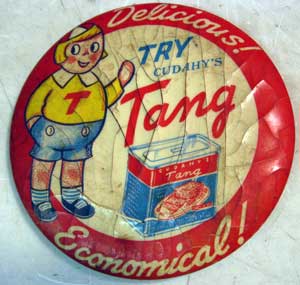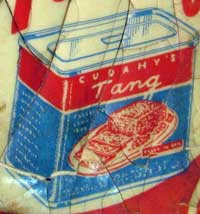There have been three brand-new episodes broadcast recently. Did you catch them?
• Three weeks ago, it was Shank of the Evening, in which we talked about sports nicknames, flounder vs. founder, Laundromats vs. washaterias, Black Dutch, nosebaggers, medical slang, and more. Download the MP3.
• Two weeks ago, it was And The Horse You Rode In On, in which we talked about the difference between cursing and cussing, “it’s all chicken but the gravy,” synonyms for armpit, whether you can trust Wikipedia, stove up, and more. Download the MP3.
• Just this past weekend, we aired Like a Bad Penny, featuring names of high school cliques, the Great Recession, favorite letters of the alphabet, taking umbrage, fudgies, flatlanders, washrag vs. washcloth, and more. Download the MP3.
The “Tang” Recipe Mystery Is Solved!
In that last episode, we also finally explained a mysterious “tang”!
To refresh your memory, in October we took a call from Lynne in Plano, Texas.
The mother of her friend in Jackson, Mississippi, died leaving a spiral-bound notebook containing planned dinners for September 1947. In a couple of the recipes there was a curious entree: tang with molasses, and tang with Karo syrup.
Lynne wanted to know: what was that tang?
We were stumped and we asked you for your help.
A few things could be eliminated right away.
We knew it wasn’t the orange powdered space-age drink Tang, as Grant speculated when we first took the call. The drink Tang didn’t appear until about ten years later.
And despite the hordes of listeners who copied and pasted and sent the Wikipedia entry, it wasn’t — was not — tang the fish. That tropical fish has never been cultivated for food, and there’s not much chance it was an accidental catch that you could expected to find on a menu 250 miles inland from the Gulf of Mexico.
Even further, it would have been passing strange to see such a fish show up on those menus given that everything else on them is ordinary: baked potato, greens, pineapple salad, butterscotch pudding, tea, and the like. What would a tang fish (a kind of surgeonfish) be doing there?
A few people suggested it was a Southern pronunciation of “tongue,” as in “beef tongue.” We liked that a little bit but could find no corroborating evidence.
None of these explanations were convincing to us. We were still stumped.
Well, we recently re-aired that episode from October. You all were evidently again racking your brains on the subject, as even more of the same kinds of explanations came in.
This time, we had answer. A correct answer. From just one person.
It comes from Barry Lynn in Casa de Oro, California, just outside of San Diego.
Barry sent us pictures of an antique button, the kind you pin on your clothes. Here it is:

It says “Try Cudahy’s Tang! Delicious! Economical!” Click the image for a big version.
Next to a cartoon of a fat-bellied boy on the pin is a tin of processed meat that looks just like a can of Spam.

And, in fact, it is indeed a knock-off of Spam. A heavily processed, salted, and mildly spiced pork product squeezed into a can for long shelf life. Spam appeared in about 1937 and Tang about four years later.
That goes perfectly with the rest of the menu, doesn’t it?
Now some of you in Cudahy, Wisconsin, or Cudahy, California, are probably having Eureka moments.
Both of those towns were named for Irishmen by the name of Cudahy, pronounced KOO-duh-hay, or rarely, KOO-duh-hee, who at one time all together controlled some of the biggest meat-packing and processing plants in the United States.
They knew a good thing when they saw it, and like more than 100 other companies, made their own version of Spam. Others went by the names of Treet, Preem, and Mor.
Tang was big enough at one time that it was advertised in Life magazine and appeared in the grocery supplements of newspapers around the country.
Unfortunately for the Cudahys, it never caught on as much as Spam did and by the 1960s there was no trace of it.
Food and language! Our heaven! A big thanks to Lynne and Barry.
Peace and love,
Martha and Grant




